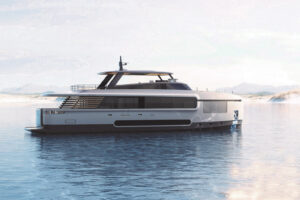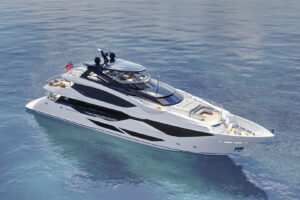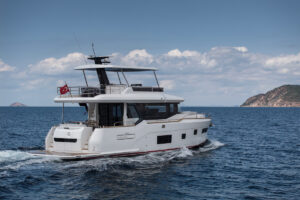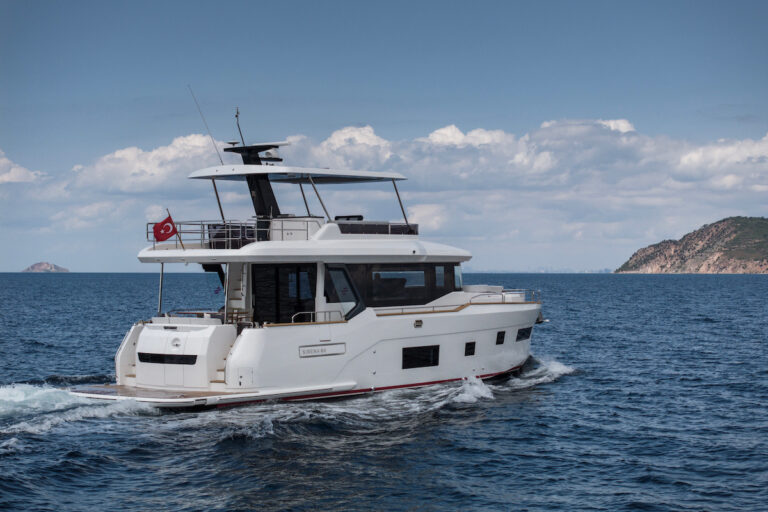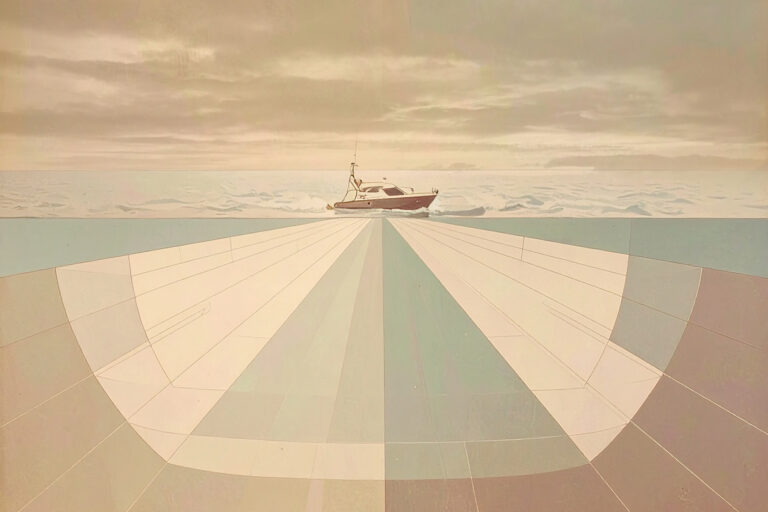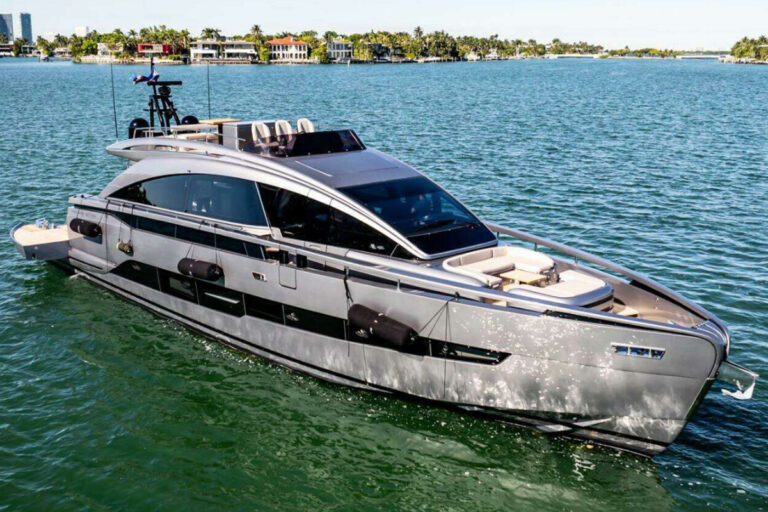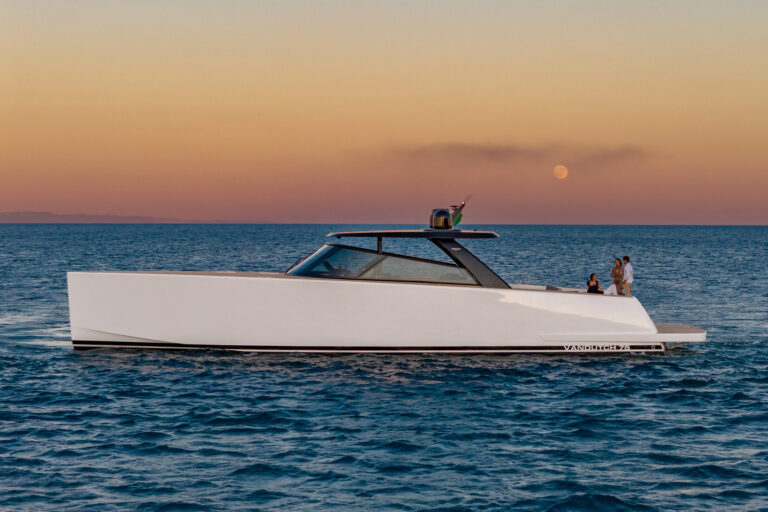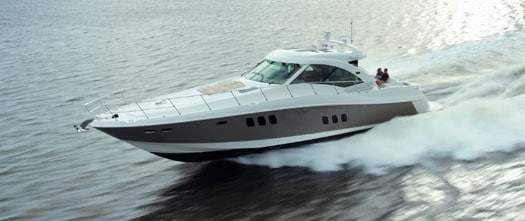
yachting/images/magazine/2006/042006/fea_searay2_525x221.jpg
When I arrived at Sea Ray‘s Sykes Creek yard in Merritt Island, Florida, at 6:30 a.m. the lights were already on. The prototype Sundancer 60 was resting in the lift slings as a team of production engineers completed their final checks and then lowered her into the water. Like all new Sea Rays, she had already been through hours of evaluation and testing. It is a virtually seamless cycle of product development that goes on year-round at Sea Ray. Still, as the craftsmen watched us idle out of the creek, it was clear that each felt a share of equity in the new Sundancer.
Since its inception, the Sundancer brand has been applied to some of Sea Ray’s most creative products. When I was offered the opportunity to help shuttle the Sundancer 60 prototype to its debut at the Miami International Boat Show, I accepted without hesitation. What better way could there be to measure this well-established marque?
But in the winter months Florida’s weather is somewhat unpredictable as the winds clock aggressively around passing fronts. With the luck of the draw, winds and seas were such that running offshore would have been at best unpleasant. Even the Intracoastal Waterway was stirred up, but the 60 had no problem slicing through the chop. She came up evenly on a plane with no appreciable bow rise. Her two 1,100 hp electronically controlled, common-rail MAN diesels reached maximum turns in approximately 30 seconds without hesitation or clouds of black smoke, and I recorded a maximum speed of 34.8 knots. With the smooth electronic controls set at 1900 rpm, I measured 26.5 knots and the MAN electronics indicated a fuel burn of 62 gallons per hour. Not bad considering we were fully loaded with fuel and bucking a 20-knot headwind. Sound levels were a relatively quiet 77 dBA at the helm and varied from 77 to 80 dBA below. Cruising at 2200 rpm yielded a steady 32.4 knots. Although the MAN analog-style electronic instrumentation is easy to read, it took me a bit of time to get used to its position on an overhead console with two large navigation displays as the centerpiece of the dash.
As we sped down the waterway in the comfort of this 60,000-pound boat, it tickled my mind to consider that the 60’s lineage dates back to a 24-footer that launched the Sundancer line in 1974. Sea Ray‘s goal at the time had been to squeeze more interior accommodations into an express design without compromising the exterior layout. The design team’s solution was two-fold. First, the designers chose a sterndrive propulsion system that places the machinery further aft. Second, they raised the bridge area high enough to allow headroom below for a mid-cabin. The first tiny Sundancer was a hit with young families who needed a spot to stash the kids, and its popularity spawned a fleet of successful larger designs. By the 1990s Sea Ray had stretched the Sundancer concept to 63 feet. Transom-mounted Arneson surface-piercing drives kept machinery aft, optimizing interior space. The 63 was an impressive ride, but I have always felt her design was a step outside the box. While her 40-knot-plus top speed proved Sea Ray could compete in the high performance yacht market, the boat did not seem in cadence with the Sundancer mantra. In light of this history, the 60 Sundancer shines. She achieves excellent performance without complication and carries a foot more beam than the 63.
Like her current closest of kin in the Sundancer lineup, the 60 has conventional shafting. To maximize usable interior volume a reverse-angle gear configuration was chosen. For most, this will provide a familiar feel compared with surface drives, which require more skill to operate. The net result is that the 60 fits perfectly within an envelope of performance and comfort that I suspect Sundancer owners desire and expect as they move up through the line. For a production builder as prolific as Sea Ray, this sort of consistency is a hard-earned asset and, I believe, one of the key ingredients of the builder’s success.
The 60’s look will also please fans of the marque as it fits neatly in the evolutionary path of the Sundancer line. Distinctive styling cues like her sloped window line and integral arch/hardtop reflect the latest thinking in Sea Ray‘s design department. It is interesting to note, however, that she does not feature the swooping sheer that Sea Ray has been exploring on other designs of late. While this look is dramatic, I prefer the 60’s relatively conservative sweep, which will likely extend her shelf life in terms of eye-appeal.
The 60’s above-deck areas are also arranged a bit differently. The open, serpentine seating and entertainment spaces common on other models have been superceded with a less busy, minimalist design. The optional passerelle and transom warping windlasses listed in the 60’s specifications suggest Sea Ray’s inspiration-clearly the builder has an eye on the European market. The cockpit has built-in seating, a table and teak chairs. Dining alfresco, perhaps? A curved glass and stainless steel sliding door leads forward to the enclosed teak-soled bridge or “sun room. There is built-in seating and a wet bar that can be fitted with a refrigerator or a wine chiller. A flat-screen TV on a lift is hidden in the cabinetwork and appears with a push of a button. The bridge is air-conditioned and has windshield vents and two electrically actuated sunroofs. I found the adjustable Stidd helm and companion seating almost too comfortable and the 60’s electronics package quite complete. The helm position is relatively high and the view fore and aft is superior to what you get on most yachts of this size and type.
A sliding acrylic door adjacent to the helm leads below deck. The saloon has curved sofa seating positioned to take advantage of a built-in 32-inch flat-screen TV. An open galley area has faux granite countertops and is equipped with Sub-Zero undercounter refrigeration. Natural light filters through skylights and hullside windows. In Sundancer fashion, the area beneath the 60’s bridge is valuable real estate-a full-beam master stateroom with a queen berth and a private head. Again, hullside windows provide natural light. A flat-screen TV is fitted to the bulkhead and a refrigerator is hidden in the cabinetwork. A washer/dryer is located conveniently nearby in the passageway. The forward cabin has an island queen and direct access to a head that is shared with a second guest cabin with upper and lower berths. The 60’s interior is finished in computer-cut perfection with cherry wood. First-class hardware and fixtures are standard fare and owners have a wide range of soft goods to choose from.
The 60’s hull and superstructure are built with a combination of stitched and woven reinforcements and polyester resin. A vinylester resin skin coat is applied below the waterline to prevent blistering. The bottom is a solid laminate supported by a network of fiberglass stringers. Balsa coring is used to stiffen the exterior decks. Much has changed since the first Sundancer’s plug was sculpted by hand. The 60’s tooling was designed on computer and cut by a computer-controlled five-axis mill. The detail and tolerances are as near perfection as is possible and the gelcoat surfaces glisten. These days resin is delivered to Sea Ray by tanker truck and each batch is tested before it is accepted. The intelligent application of technology and quality control are the reasons a prototype like the 60 is virtually turnkey.
The 60’s standard package is fairly complete; however, there are a few items serious cruisers should consider. If I planned on visiting the Bahamas, I would opt for the watermaker and the isolation transformer. I would resist, but the kids would insist on the satellite TV system and reality would require a satellite phone. Several electronics packages are offered featuring Raymarine and Northstar components as well as the Sea Ray Navigator III touch-screen system.
While I would have expected that a 225-mile run with a prototype fresh out of the box would have shaken out a few loose ends, the 60 pulled it off without a hitch. The team at Sea Ray has invested its best in the 60 and clearly the investment has paid off. This is a worthy new flagship for the Sundancer brand.
Contact: Sea Ray Boats, (800) SRBOATS; www.searay.com

